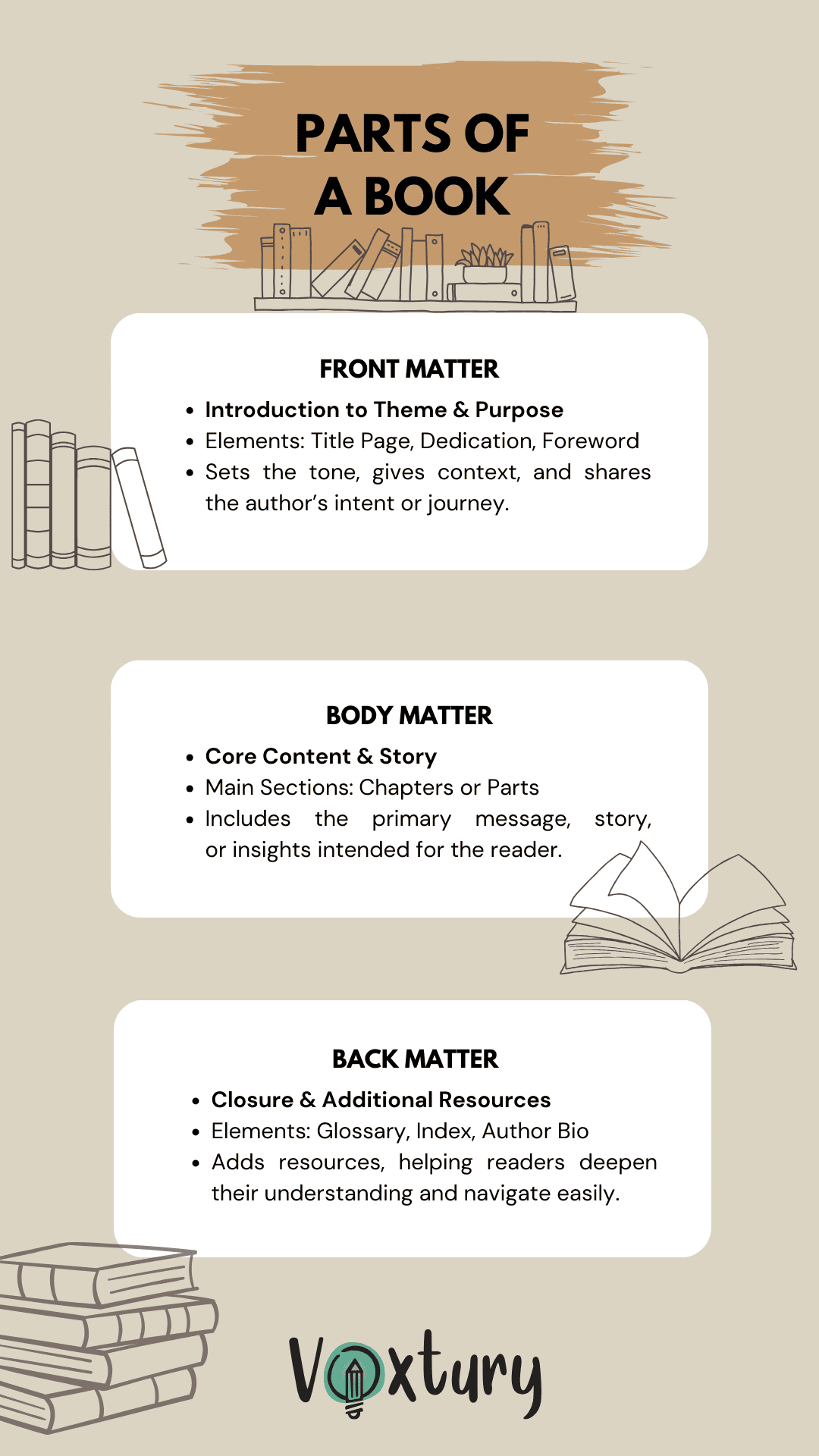When you open a book, you may think the story or information begins on the first page of Chapter One, but there’s much more that goes into a book’s structure than meets the eye. From the dedication to the index, each section plays a specific role in shaping a complete and cohesive reading experience. Knowing the essential parts of a book isn’t just useful for readers; it’s vital for authors and editors who want to create a professional, polished final product.
In this article, we’ll explore the foundational components of a book, from the front matter that introduces the work to the back matter that closes it out. Whether you’re crafting a novel, a non-fiction guide, or an academic publication, understanding these sections will help you engage your readers and convey your content clearly and effectively. Let’s begin!
Key Takeaways
- Understanding the structure of a book enhances readability, professionalism, and flow.
- The Front Matter introduces the book with elements like the title page, preface, and prologue, setting the tone and providing context.
- The Body Matter is the main content, organized into chapters and sections, with optional visuals to enhance understanding.
- The Back Matter includes additional resources, such as the epilogue, appendix, glossary, and index, adding value and clarity for the reader.
The Basics of Book Structure

Every book is built on a thoughtful structure that guides readers through a cohesive journey, from the initial pages to the final thoughts. While it may seem like the primary purpose of a book is to deliver the main content, each section—often referred to as “front matter,” “body matter,” and “back matter”—plays an integral role in shaping the reader’s experience.
Front Matter is where readers are introduced to the book’s theme and purpose, often through elements like the title page, dedication, or a brief foreword. These introductory components set the tone, provide necessary context, and sometimes even offer a glimpse into the author’s journey or intent behind the work.
Body Matter is the core of the book, comprising the main content, such as chapters or sections, where the story unfolds or the information is presented in full. This is the heart of the book, the part that delivers the message, story, or insights intended for the reader.
Back Matter provides closure and additional resources, often offering supplementary material like glossaries, indexes, and author bios. For many readers, this section can be a valuable source of extra information, guiding them to a deeper understanding or helping them navigate the book more easily.

Front Matter: The Beginning Elements of a Book
The front matter of a book serves as the gateway to the main content, setting the stage and preparing readers for what’s to come. While it may seem like just a prelude, each part in the front matter is carefully chosen to guide the reader into the story or subject with context, intrigue, and insight.
Below, you’ll find a breakdown of the typical components you’ll find in the front matter and their unique functions:
Title Page
The title page is usually one of the first pages readers see. It includes the book’s title, subtitle (if applicable), author’s name, and often the publisher’s name or logo. This page gives a formal introduction to the book, ensuring readers immediately recognize the work they’ve chosen.
Copyright Page
Found right after the title page, the copyright page provides legal information, including the copyright notice, year of publication, and any necessary disclaimers. It’s a critical page for protecting the author’s intellectual property and sometimes includes additional details like ISBN and printing information. Learn more about the copyright page here.
Dedication
Often one of the most personal parts of the book, the dedication allows authors to acknowledge those who have inspired or supported them in the book’s creation. It’s a simple, heartfelt note that connects readers to the author’s journey in a personal way.
Epigraph
An epigraph is a brief quote or passage that appears before the main content, offering readers a taste of the book’s themes or tone. Authors often select epigraphs to set a mood or inspire readers. To dive deeper into the role of an epigraph, check out our guide here.
Preface
The preface is where authors have the chance to share the story behind the story—why they wrote the book, what they hope to achieve, and any key insights that led to its creation. It’s a unique way for authors to connect with readers on a personal level. Read more about the purpose and style of prefaces here.
Prologue
Often found in fiction, the prologue sets up the main narrative by introducing characters, backstory, or events that provide context. A well-crafted prologue draws readers in, creating a bridge to the main story while igniting curiosity. For more on prologues, explore our article here.
Keep in mind
The front matter is more than just the preliminary pages; it’s a carefully structured introduction that engages readers, offers insights, and gives the book a professional touch. Authors who take the time to thoughtfully organize their front matter give readers a polished, inviting entry into their work.
Related article: What is narrative writing?
Body Matter: The Core Content of the Book

The body matter is the heart of the book—the main content that readers came for. This is where the story unfolds, ideas are developed, and key information is presented. Each part of the body matter is structured to create an immersive experience, whether through well-organized chapters, illustrative visuals, or thoughtful headings.
Get a closer look at the essential components that make up the body matter:
Chapters and Parts
Books are often divided into chapters and, in longer works, parts or sections. Chapters break down the content into manageable segments, guiding the reader through the story or information in a logical sequence. Parts are often used to group related chapters or sections, making it easier for readers to follow major themes, shifts in setting, or changes in topic. In non-fiction books, parts and chapters are sometimes prefaced with headings or summaries to give readers a quick overview of what each section will cover.
Illustrations and Tables
Visual elements like illustrations, tables, maps, charts, or photos are common in both fiction and non-fiction works. In children’s books, illustrations bring stories to life, while in non-fiction, tables and charts can simplify complex data, enhancing the reader’s understanding. These visuals are woven into the body matter to support or add value to the written content, making information more accessible and engaging.
In a nutshell
The body matter is the essence of any book, capturing readers’ attention and delivering the message the author wants to convey.
Related article: Essential story writing tips
Back Matter: Closing Sections of a Book
The back matter wraps up the book, offering readers a place to find additional resources, detailed references, and supplementary insights. Although it comes after the main content, the back matter serves as a valuable section that can enhance the reader’s understanding and provide lasting value.
Here are the typical components you’ll find in the back matter and their purposes:
Epilogue
Often found in novels, the epilogue provides a sense of closure by revealing what happens to characters after the main events of the story. It offers readers a glimpse into the future, tying up any remaining loose ends. Learn more about how authors use epilogues to conclude stories effectively here.
Appendix
In non-fiction books, the appendix is used to present supplementary information that may be too detailed or technical for the main content. This section can include additional data, charts, documents, or references that support the book’s main points, offering readers a deeper understanding of complex topics.
Glossary
Common in academic and technical books, the glossary provides definitions for specialized terms used throughout the book. This section is especially helpful for readers who may be unfamiliar with the subject matter, making the book’s content more accessible and easy to understand.
Index
The index is a valuable tool for readers, especially in non-fiction works, providing an alphabetical list of topics, names, and concepts covered in the book, along with page numbers for easy reference. It allows readers to locate specific information quickly and is essential for textbooks, manuals, and reference books.
Author Bio
Typically found in the back of the book, the author bio provides readers with a brief overview of the author’s background, credentials, and accomplishments. This section helps readers connect with the author on a more personal level, adding context to the expertise or experience that informs the book’s content.
Worth remembering
The back matter serves as the closing chapter to the book, adding resources, clarity, and a sense of completeness.
Related Article: Guide to Writing a Manuscript
Why Understanding Book Parts Is Important for Authors and Editors

For authors and editors, understanding the parts of a book is essential to crafting a professional and cohesive final product. Each section—whether it’s the introduction provided by the front matter, the core content in the body matter, or the concluding resources in the back matter—plays a vital role in creating a seamless reading experience that keeps readers engaged and informed. Here’s why:
Better Readability and Flow
A well-organized book guides readers naturally from one part to the next. Each section builds on the previous one, helping readers feel grounded in the content without getting lost or overwhelmed. Authors and editors who understand book structure can arrange content logically, making it easier for readers to absorb information or follow the story.
Professional Presentation
Readers expect a certain level of structure and clarity in professionally published books. Properly arranged parts, such as a clear title page, a compelling preface, or a concise index, add credibility to the work. Paying attention to these elements can elevate the book’s professionalism and make it more appealing to both readers and publishers.
Enhanced Reader Engagement
Thoughtfully placed elements like epigraphs, glossaries, or author bios can deepen readers’ connection to the material. These additions provide context, spark curiosity, and can even inspire readers to explore further. A well-structured book draws readers in and keeps them engaged, making the reading experience more enjoyable and memorable.
Efficient Editing and Revision
When editors and authors understand the purpose of each book part, they can approach the editing process more effectively. For instance, knowing the distinct roles of the preface, epilogue, and appendix helps editors focus on maintaining clarity, consistency, and relevance within each section, leading to a polished final product.
Related article: How to edit a book
Parts of a Book – Final Thoughts
Every part of a book has a purpose, working together to create a smooth and memorable experience for the reader. When authors and editors truly understand each section—from the intriguing preface to the useful index—they’re able to craft a book that flows naturally, captivates readers, and feels polished and professional.
Ready to learn more? Dive into our related guides on the copyright page, preface, prologue, epigraph, and epilogue to build a solid foundation for your next project. With these insights, you’ll have everything you need to create a book that doesn’t just tell a story but leaves a lasting impression.
Ready to perfect your own work? Explore Voxtury’s editing tools to elevate your writing.
SOURCES
At Voxtury, we prioritize using high-quality sources, including peer-reviewed studies, to ensure our articles are accurate, reliable, and trustworthy. To learn more about our commitment to quality and how we fact-check our content, please visit our editorial process page.
- Chapman, C. – Understanding the Parts of a Book
- Emmorey, B. – What Are the Parts of a Book? The Ultimate Breakdown
- Jenkins, J. – The Parts of a Book